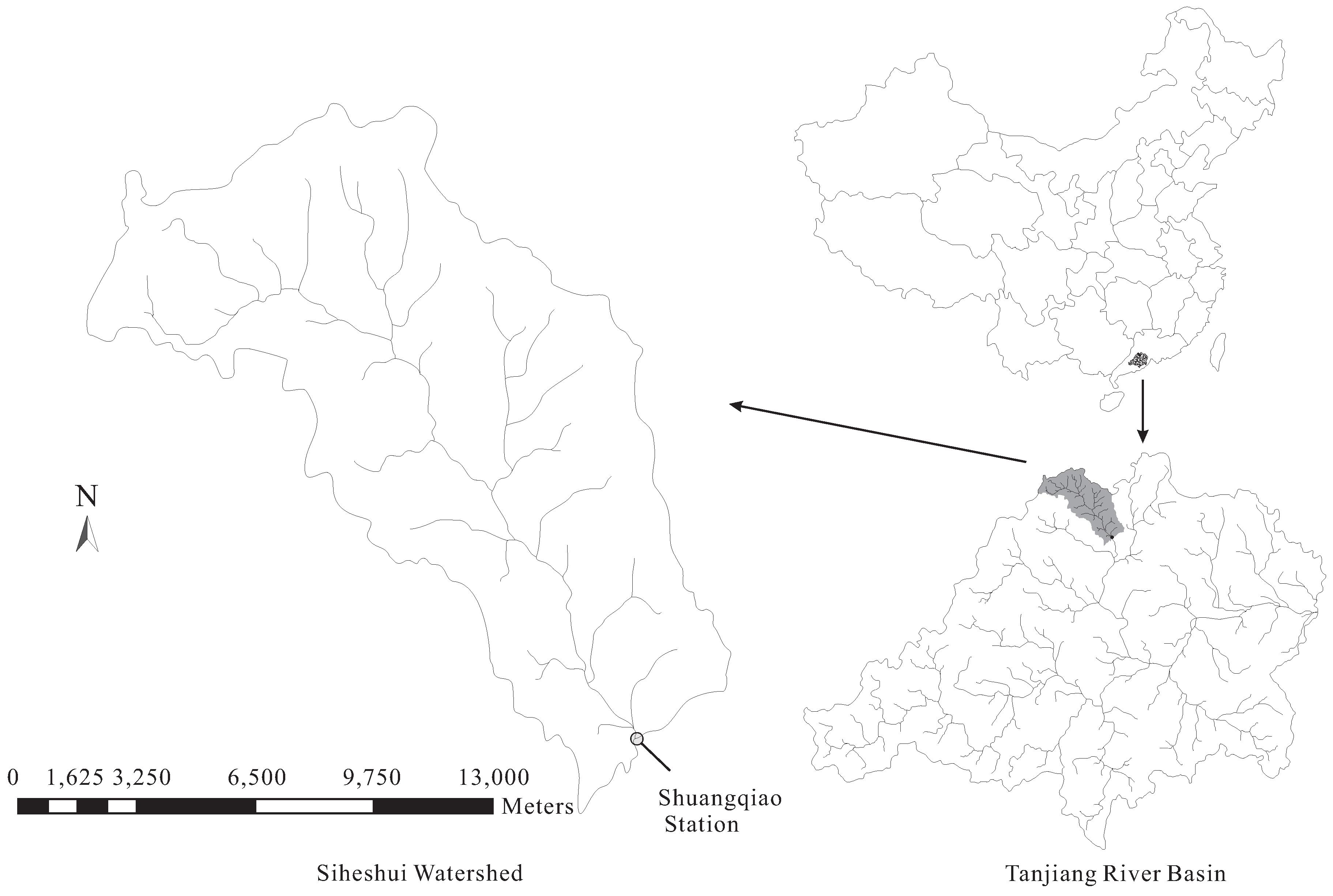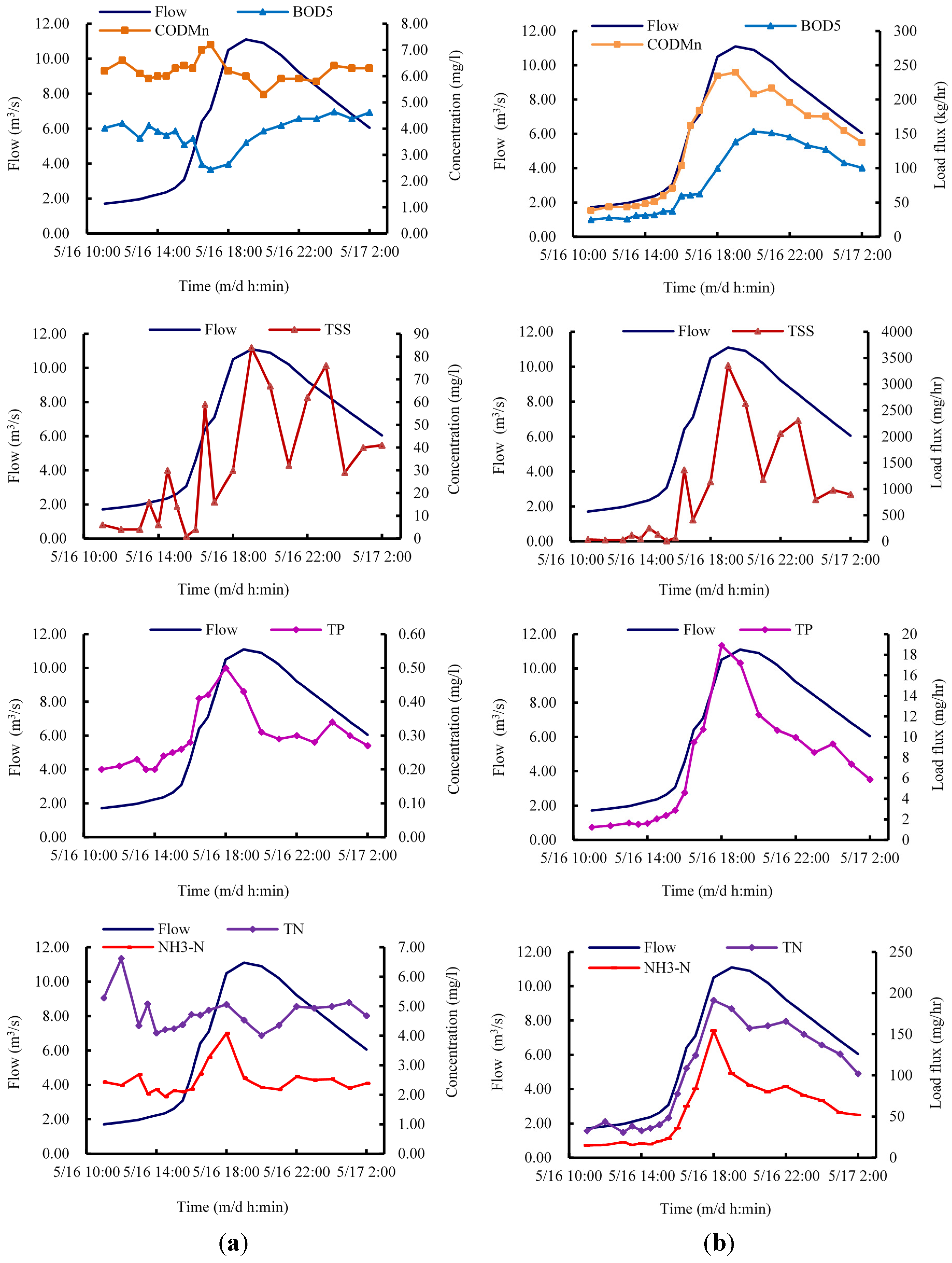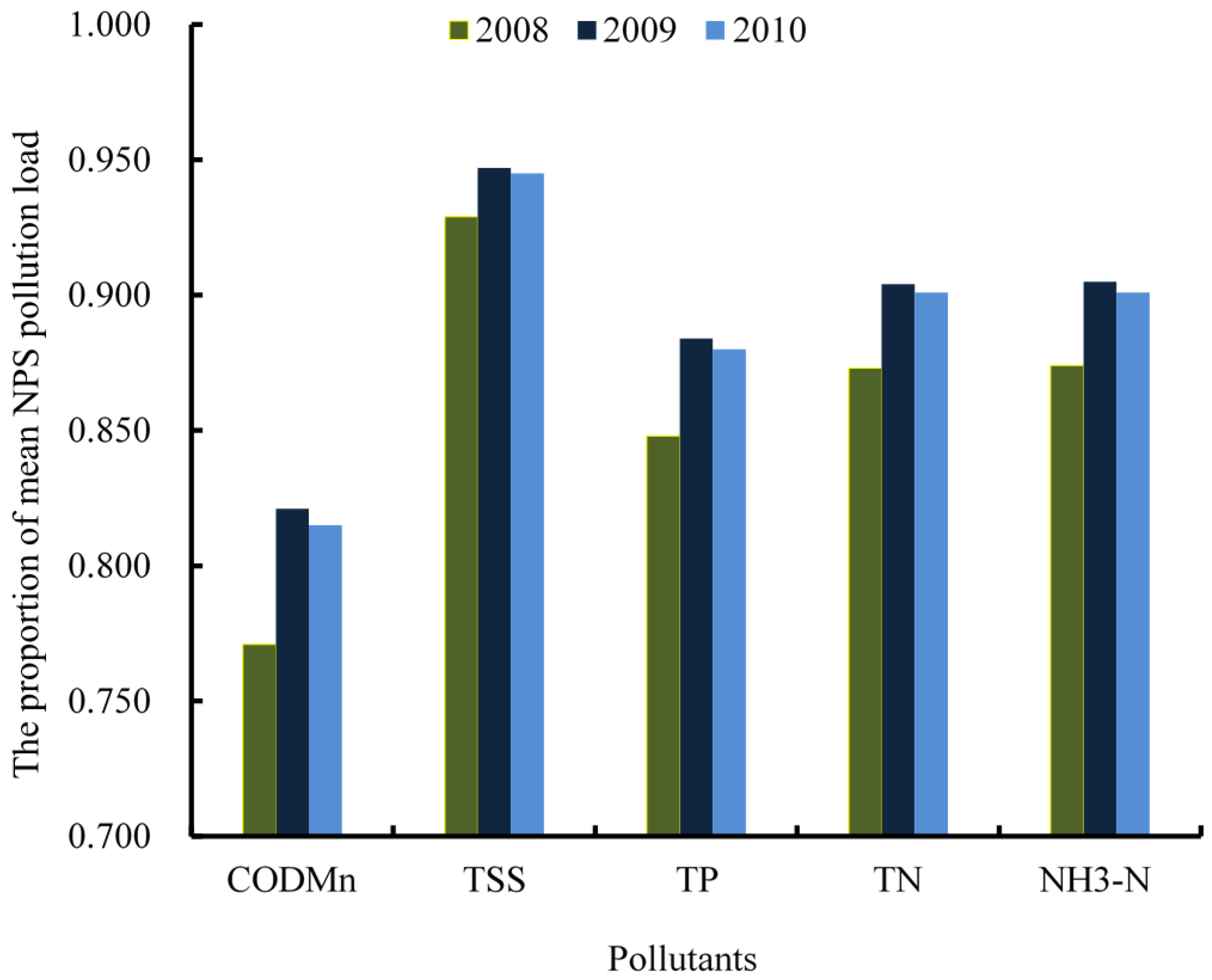Monitoring of Non-Point Source Pollutions from an Agriculture Watershed in South China
Abstract
:1. Introduction
2. Materials and Methods
2.1. Study Area

2.2. Sample Collection
| Flood (yy-mm-dd) | Rainfall Amount (mm) | Rainfall Amount in the Day before the Event (mm) | Rainfall Intensity (mm/h) | Peak Flow (m3/s) |
|---|---|---|---|---|
| 11-05-16 | 32.6 | 7.9 | 4.1 | 11.1 |
| 11-05-22 | 31.8 | 16.4 | 2.9 | 10.5 |
| 11-06-29 | 132.5 | 1.0 | 4.6 | 35.5 |
| 11-07-12 | 48.5 | 2.5 | 3.7 | 8.2 |
| 11-07-19 | 70.5 | 4.0 | 5.4 | 25.7 |
| Non-flood | - | - | - | 0.8 |
2.3. Data Analysis
2.3.1. EMC Method
2.3.2. Mean Concentration Method
2.3.3. Calculation of the Pollutant Load Flux
3. Results and Discussion
3.1. The Characteristics of EMCs for Pollutants
| Constituent | BOD5 (mg/ L) | CODMn (mg/L) | TSS (mg/L) | TP (mg/L) | TN (mg/L) | NH3-N (mg/L) |
|---|---|---|---|---|---|---|
| 11-05-16 (flood) | 3.80 | 6.10 | 45.33 | 0.34 | 4.73 | 2.61 |
| 11-05-22 (flood) | 2.82 | 6.49 | 18.01 | 0.30 | 3.13 | 1.39 |
| 11-06-29 (flood) | 3.13 | 5.43 | 87.43 | 0.21 | 4.19 | 1.63 |
| 11-07-12 (flood) | 2.69 | 6.15 | 24.20 | 0.40 | 2.66 | 1.22 |
| 11-07-19 (flood) | 3.34 | 5.38 | 51.40 | - | 2.08 | 1.19 |
| Mean (flood) | 3.14 | 5.75 | 58.31 | 0.26 | 3.52 | 1.56 |
| Max. (flood) | 3.80 | 6.49 | 87.43 | 0.40 | 4.73 | 2.61 |
| Min. (flood) | 2.69 | 5.38 | 18.01 | 0.21 | 2.08 | 1.19 |
| Cn (non-flood) | - | 5.17 | 15.21 | 0.15 | 1.70 | 0.78 |
| Max. Cf/Cn | - | 1.26 | 5.75 | 2.67 | 2.78 | 3.35 |
| Mean Cf/Cn | - | 1.14 | 2.98 | 2.07 | 1.98 | 2.06 |
3.2. The Characteristics of the Pollutant Concentrations during Flood

3.3. The Characteristics of the Pollutant Load Fluxes during Flood
3.4. Correlation Analysis between EMCs and Rainfall Runoff Characteristics
| Constituent | Rainfall Amount | Rainfall Intensity | Peak Flow |
|---|---|---|---|
| BOD5 | −0.037 | 0.492 | 0.172 |
| CODMn | −0.797 | −0.944 | −0.888 |
| TSS | 0.901 | 0.682 | 0.918 |
| TP | −0.769 | −0.415 | −0.894 |
| TN | 0.130 | −0.169 | 0.073 |
| NH3-N | −0.200 | −0.052 | −0.154 |
3.5. Estimation of NPS Pollution Load
| Rainfall Event | CODMn (mg/L) | TSS (mg/L) | TP (mg/L) | TN (mg/L) | NH3-N (mg/L) |
|---|---|---|---|---|---|
| 11-05-16 | 6.45 | 50.56 | 0.37 | 5.24 | 2.89 |
| 11-05-22 | 6.51 | 43.64 | 0.34 | 4.67 | 2.42 |
| 11-06-29 | 5.47 | 92.40 | 0.21 | 4.26 | 1.65 |
| 11-07-12 | 6.30 | 26.72 | 0.44 | 2.83 | 1.30 |
| 11-07-19 | 5.41 | 52.11 | - | 2.08 | 1.20 |
| Mean | 5.82 | 66.56 | 0.28 | 3.92 | 1.81 |
| Index | CODMn (kg/(hm2·Year)) | TSS (kg/(hm2·Year)) | TP (kg/(hm2·Year)) | TN (kg/(hm2·Year)) | NH3-N (kg/(hm2·Year)) |
|---|---|---|---|---|---|
| 2008 | 38.93 | 445.17 | 1.87 | 26.22 | 12.11 |
| 2009 | 53.11 | 607.42 | 2.56 | 35.77 | 16.52 |
| 2010 | 51.00 | 583.27 | 2.45 | 34.35 | 15.86 |
| Average | 47.68 | 545.29 | 2.29 | 32.11 | 14.83 |

4. Conclusions
Acknowledgments
Author Contributions
Conflicts of Interest
References
- Leone, A.; Ripa, M.N.; Uricchio, V.; Deak, J.; Vargay, Z. Vulnerability and risk evaluation of agricultural nitrogen pollution for Hungary’s main aquifer using DRASTIC and GLEAMS models. J. Environ. Manag. 2009, 90, 2969–2978. [Google Scholar] [CrossRef]
- Yang, J.L.; Zhang, G.L.; Shi, X.Z. Dynamic changes of nitrogen and phosphorus losses in ephemeral runoff processes by typical storm events in Sichuan Basin, Southwest China. Soil Tillage Res. 2009, 105, 292–299. [Google Scholar] [CrossRef]
- Novotny, V. Diffuse pollution from agriculture—A worldwide outlook. Water Sci. Technol. 1999, 39, 1–13. [Google Scholar] [CrossRef]
- Ongley, E.D.; Zhang, X.L.; Yu, T. Current status of agricultural and rural non-point source pollution assessment in China. Environ. Pollut. 2010, 158, 1159–1168. [Google Scholar] [CrossRef] [PubMed]
- Arnold, J.G.; Allen, P.M.; Bernhardt, G.A. Comprehensive surface-ground-water flow model. J. Hydrol. 1993, 142, 47–69. [Google Scholar] [CrossRef]
- Vitousek, P.M.; Aber, J.D.; Howarth, R.W.; Likens, G.E.; Matson, P.A.; Schindler, D.W.; Schlesinger, W.H.; Tilman, D.G. Human alteration of the global nitrogen cycle: Sources and consequences. Ecol. Appl. 1997, 7, 737–750. [Google Scholar]
- Carpenter, S.R.; Caraco, N.F.; Correl, D.L.; Howarth, R.W.; Sharpley, A.N.; Smith, V.H. Non-point pollution of surface waters with phosphorus and nitrogen. Ecol. Appl. 1998, 8, 559–568. [Google Scholar] [CrossRef]
- Novotny, V.; Olem, H. Water Quality Prevention, Identification, and Management of Diffuse Pollution; Van Nostrand Reinhold: New York, NY, USA, 1994. [Google Scholar]
- Detenbeck, N.E.; Elonen, C.M.; Taylor, D.L.; Anderson, L.E.; Jichia, T.M.; Batterman, S.L. Effects of hydrogeomorphic region, catchment storage and mature forest on baseflow and snowmelt stream water quality in second-order Lake Superior Basin tributaries. Freshw. Biol. 2003, 48, 912–927. [Google Scholar] [CrossRef]
- Leon, L.F.; Soulis, E.D.; Kouwen, N.; Farquhar, G.J. Nonpoint source pollution: A distributed water quality modeling approach. Water Res. 2001, 35, 997–1007. [Google Scholar] [CrossRef] [PubMed]
- Young, R.A.; Onstad, C.A.; Bosch, D.D.; Anderson, W.P. AGNPS: A non-point source pollution model for evaluating agriculture watersheds. J. Soil Water Conserv. 1989, 44, 168–173. [Google Scholar]
- Hassen, M.; Fekadu, Y.; Gate, Z. Validation of agricultural non-point source (AGNPS) pollution model in Kori watershed, South Wollo, Ethiopia. Int. J. Appl. Earth Observ. Geoinform. 2004, 6, 97–109. [Google Scholar] [CrossRef]
- He, C.S. Integration of geographic information systems and simulation model for watershed management. Environ. Modell. Softw. 2003, 18, 809–813. [Google Scholar] [CrossRef]
- Beasley, D.B.; Huggins, L.F.; Monke, E.J. ANSWERS: A model for watershed planning. Trans. Am. Soc. Agric. Eng. 1980, 23, 938–944. [Google Scholar] [CrossRef]
- Shen, Z.Y.; Hong, Q.; Yu, H.; Liu, R. Parameter uncertainty analysis of the non-point source pollution in Daning river watershed of the Three Gorges reservoir area, China. Sci. Total Environ. 2008, 405, 195–205. [Google Scholar] [CrossRef] [PubMed]
- Recanatesi, F.; Ripa, M.N.; Leone, A.; Perini, L.; Salvati, L. Land use, climate and transport of nutrients: Evidence emerging from the Lake Vicocase study. Environ. Manag. 2013, 52, 503–513. [Google Scholar] [CrossRef]
- National Environmental Protection Bureau (NEPB). Standard Methods for the Examination of Water and Wastewater; Version 4; China Environmental Science Publish Press: Beijing, China, 2002. [Google Scholar]
- Charbeneau, R.J.; Barretti, M. Evaluation of methods for estimating stormwater pollutant loads. Water Environ. Res. 1998, 70, 1295–1302. [Google Scholar] [CrossRef]
- John, J.S.; Steven, G.B. Partitioning and first flush of metals in urban roadway storm water. J. Environ. Eng. 1997, 123, 134–143. [Google Scholar] [CrossRef]
- Li, H.E. Mean concentration method for estimation of nonpoint source load and its application. Acta Sci. Circumst. 2000, 20, 397–400. [Google Scholar]
- Zhuo, M.N.; Wu, Z.F.; Wang, J.Z.; Li, F.B.; Wan, H.F. Study on the characteristics of pollution in precipitation runoff in Zhuhai urban area. Acta Pedol. Sin. 2003, 40, 775–778. [Google Scholar]
- Yoon, S.W.; Chung, S.W.; Oh, D.G.; Lee, J.W. Monitoring of non-point source pollutants load from a mixed forest land use. J. Environ. Sci. 2010, 22, 801–805. [Google Scholar] [CrossRef]
- Zhang, R.B.; Yao, Q.; Ji, Y. A study on law of non-point source pollutants losses in a typical small watershed of Taihu basin. Resour. Environ. Yangtze Basin 2005, 14, 94–98. [Google Scholar]
- Hu, Y.A.; Cheng, S.T.; Jia, H.F. Regular pattern of non-point source pollutants losses in Luxi Watershed. Environ. Sci. 2004, 25, 108–112. [Google Scholar]
- Li, J.K.; Li, H.E.; Shen, B.; Li, Y.J. Effect of non-point source pollution on water quality of the Weihe River. Int. J. Sediment Res. 2011, 26, 50–61. [Google Scholar] [CrossRef]
- Liu, P.; Cheng, J.; Liu, X.N.; Chen, Z.L.; Wu, Z.F. Characteristics of output of non-point source pollution with rainfall runoff in typical agricultural watershed of Liuxi river valley. J. Ecol. Rural Environ. 2008, 24, 92–95. [Google Scholar]
- Zhang, H.; Zeng, F.T.; Fang, H.Y.; Zhang, H.J.; Xiao, J.E.; Guo, Q.W.; Zeng, D.; Ouyang, Z. Impact of consecutive rainfall on non-point source pollution in the Danshui River catchment. Acta Sci. Circumst. 2011, 31, 927–934. [Google Scholar]
- Li, J.K.; Li, H.E.; Liu, J.; Zhang, T.; Yang, T.; Ma, S.W. Characteristics of non-point source pollution and load of Weihe river based on storm runoff monitoring data. Bull. Soil Water Conserv. 2008, 28, 106–111. [Google Scholar]
- Huang, J.; Zhang, X.; Peng, J.; Li, G.H. Temporal and spatial distribution and transportation of nitrogen and phosphorus in stormwater runoff. J. Agro Environ. Sci. 2004, 23, 255–258. [Google Scholar]
© 2014 by the authors; licensee MDPI, Basel, Switzerland. This article is an open access article distributed under the terms and conditions of the Creative Commons Attribution license (http://creativecommons.org/licenses/by/4.0/).
Share and Cite
Hu, H.; Huang, G. Monitoring of Non-Point Source Pollutions from an Agriculture Watershed in South China. Water 2014, 6, 3828-3840. https://doi.org/10.3390/w6123828
Hu H, Huang G. Monitoring of Non-Point Source Pollutions from an Agriculture Watershed in South China. Water. 2014; 6(12):3828-3840. https://doi.org/10.3390/w6123828
Chicago/Turabian StyleHu, Haiying, and Guoru Huang. 2014. "Monitoring of Non-Point Source Pollutions from an Agriculture Watershed in South China" Water 6, no. 12: 3828-3840. https://doi.org/10.3390/w6123828
APA StyleHu, H., & Huang, G. (2014). Monitoring of Non-Point Source Pollutions from an Agriculture Watershed in South China. Water, 6(12), 3828-3840. https://doi.org/10.3390/w6123828





